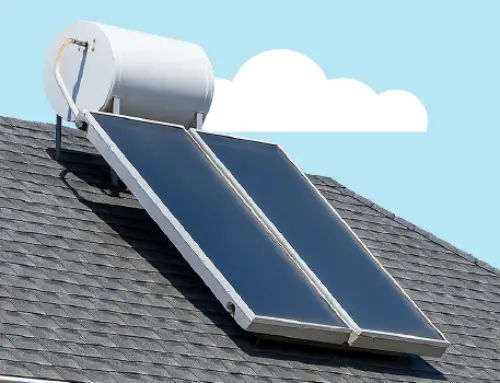21 of the Best Indoor Plants for Air Purification in Midwest Homes
by Jenna Mendez
25.7 min read
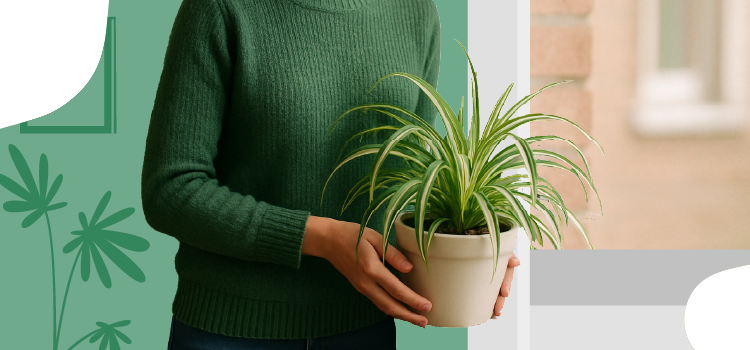
When the temperatures drop in the Midwest, most of us spend months with the windows shut tight and the heat running nonstop. While this keeps us warm through long winters, it also means indoor air can get stale, dry, and filled with hidden pollutants from cleaning products to everyday cooking fumes.
That’s where houseplants come in. Beyond adding a touch of greenery, certain indoor plants can help filter toxins, add humidity back into the air, and create a healthier living environment. And unlike electric air purifiers or humidifiers, they do it naturally, without increasing your energy bill.
In this guide, we’ll explore the best indoor plants for air purification in Midwest homes, highlight which ones thrive in low light and dry winter air, and answer common questions about plant care, safety, and effectiveness. Let’s dive in!
Key Points of This Article:
- Indoor air can sometimes be more polluted than outdoor air, according to the EPA.
- Plants help freshen the air, especially when combined with good ventilation and healthy air-quality habits.
- The Snake Plant, also called "Mother-in-Law's Tongue," is one of the toughest and most reliable houseplants.
- The best plants for indoor spaces with little light include Snake Plant, ZZ Plant, Peace Lily, Chinese Evergreen, Philodendron, and Lady Palm.
- Choosing the right potting soil is essential, as it supports healthy roots and helps plants thrive despite Midwest winters and humid summers.
Common Sources of Indoor Air Pollution
Most people think of air pollution as something that happens outside; they think of smog, car exhaust, or factory smoke. But the truth is, the air inside your home can be more seriously polluted than the air outside, according to the EPA.
This is especially true in the Midwest, where we keep windows closed for long stretches in winter, meaning pollutants can build up indoors without much fresh air circulation.
Here are the most common sources of indoor air pollution you should be aware of:
- Household cleaners and sprays can release gases called volatile organic compounds (VOCs), which can irritate your eyes, nose, and throat, make breathing harder, and in some cases even cause serious illness, including cancer.
- Building materials and furnishings such as paint, carpeting, pressed wood, and flooring often release chemicals even months after installation.
- Cooking and heating appliances like gas stoves, fireplaces, and space heaters can give off carbon monoxide and nitrogen dioxide if not properly ventilated.
- Tobacco smoke is one of the most dangerous indoor pollutants, since secondhand smoke contains thousands of harmful chemicals.
- Mold and moisture build up in damp spaces such as basements or bathrooms, releasing spores that can trigger allergies and breathing problems.
- Pet dander and dust mites collect in carpets, bedding, and furniture, creating common allergens in the home.
- Poor ventilation makes all of these problems worse by trapping pollutants indoors, especially in Midwest homes that stay sealed up during long winters.
Do Plants Really Purify the Air?
A NASA study found that certain houseplants could absorb toxins in small, sealed chambers, which sparked the idea that plants might work like natural air purifiers. In reality, the effect in our homes is much smaller.
The EPA later explained that you’d need around 680 plants in one house to match those lab results, which isn’t practical for most people. Still, plants aren’t useless when it comes to air quality.
While these indoor plants won’t replace an air purifier, they do add oxygen and a bit of natural filtration, release moisture into dry indoor air (a big bonus during Midwest winters), and create a calming environment that can reduce stress while boosting focus, memory, and creativity.
Bottom line is that plants do help, but you’ll get the most benefit when you keep a variety of them in a room and use them alongside good ventilation and other air-quality habits.
Best Indoor Plants for Air Purification in Midwest Homes
The right houseplants can do more than decorate your space; they can make your home feel fresher, cozier, and more comfortable year-round. For Midwest households, the best indoor plants for air purification are especially valuable because they handle long winters, lower light, and dry indoor air while still adding natural beauty and a sense of calm to your living spaces.
Here are some of our top picks for indoor plants that help with air purification:
1. Spider Plant (Chlorophytum comosum)
The Spider Plant is one of the best indoor plants for air purification and also one of the easiest to grow, making it a favorite for beginners and seasoned plant owners alike.
Known for its ability to reduce common indoor pollutants, the spider plant is resilient, fast-growing, and produces small “baby spiders” that can be replanted. Its long, striped leaves arch gracefully while tiny plantlets dangle like natural décor, adding both beauty and function to any space.
This plant is perfect because it adapts well to fluctuating light conditions during long winters. Hanging baskets in kitchens or living rooms are ideal locations, as the plant thrives in bright, indirect light.
With weekly watering and occasional trimming of brown tips or old leaves, the spider plant remains a fresh, reliable, and air-friendly addition to the home.
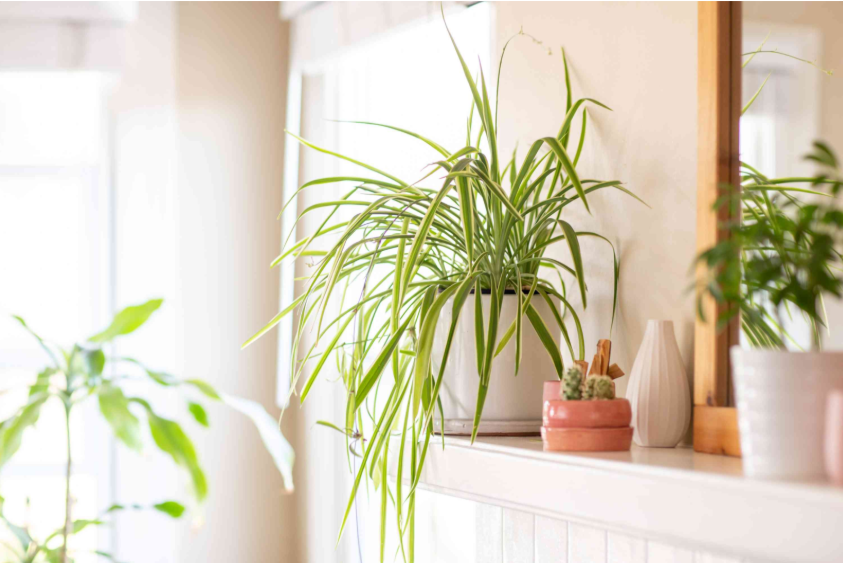
2. Snake Plant (Sansevieria trifasciata)
The Snake Plant, also known as “Mother-in-Law’s Tongue,” is one of the toughest and most dependable indoor plants for air purification.
It is unique because it releases oxygen even at night, making it an excellent choice for bedrooms. Its upright, sword-like leaves with green and yellow striping add a bold, modern touch to any space while quietly improving air quality.
This plant is especially well-suited for Midwest homes, as it tolerates dry winter air and low light conditions better than many other varieties. Snake plants thrive in bedrooms, hallways, or offices with low to medium light and require very little care. With watering needed only every two to three weeks, they remain one of the easiest and most resilient houseplants to grow.
3. Peace Lily (Spathiphyllum)
The Peace Lily is a popular indoor plant for air purification, making it especially useful in homes with dry winter air. Elegant white “flowers” (actually spathes) against dark green leaves give it a graceful look that brightens any room while also contributing to a cleaner environment.
This plant adapts well to lower light conditions, which makes it ideal for Midwest households during the winter months. Bathrooms or living rooms without strong sunlight are excellent spots for peace lilies, as they thrive in indirect light and slightly moist soil.
Regular misting during dry seasons helps maintain healthy leaves, making this plant both functional and decorative year-round.
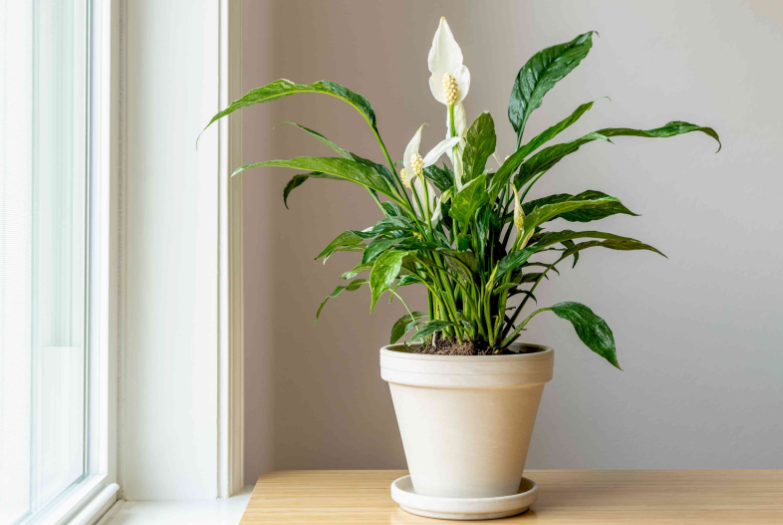
4. Aloe Vera (Aloe barbadensis miller)
The Aloe Vera is often called “the medicine plant” because of the soothing gel stored in its thick, fleshy leaves, long used to ease burns, scrapes, and even acne flare-ups.
Beyond its healing properties, aloe adds natural beauty to the home while helping freshen the air in bright rooms. Its unique, lance-shaped leaves fan out from the center, making it both functional and decorative.
This plant grows well indoors during cold months when outdoor conditions are too harsh. It thrives on sunny kitchen windowsills or in bright sunrooms, where it can soak up plenty of light.
5. Boston Fern (Nephrolepis exaltata)
The Boston Fern is an excellent natural humidifier, perfect for Midwest homes where heating systems dry out the air in winter. Its soft, feathery fronds cascade gracefully, adding lush greenery and a touch of elegance to any space.
This fern is particularly useful for balancing dry indoor air, helping create a healthier and more comfortable environment during the heating season.
The best spots for Boston ferns are bathrooms with natural light or rooms near a humidifier, where added moisture supports their growth. To keep them thriving, maintain evenly moist soil, mist the fronds regularly, and provide indirect light. With the right care, Boston ferns bring both beauty and improved air quality into the home.
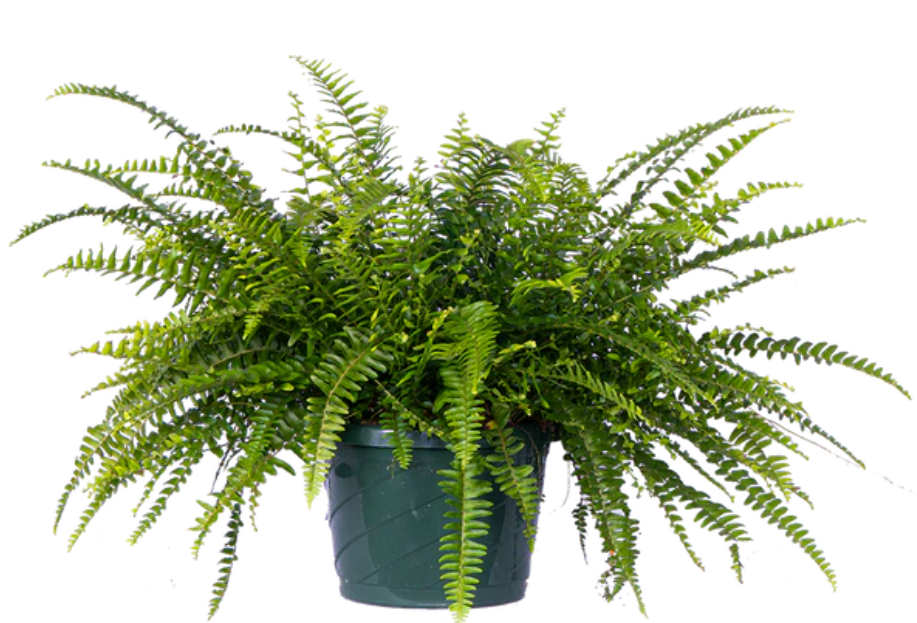
6. English Ivy (Hedera helix)
The English Ivy is a classic indoor plant known for helping reduce mold particles and other airborne irritants, making it a smart choice for damp areas of the home. Its elegant, trailing vines and rich green leaves add timeless charm, though it should be kept out of reach of children and pets, as it is toxic if ingested.
For Midwest households, English ivy is especially helpful in winter when homes are tightly sealed and air circulation is limited. It grows well in bathrooms, kitchens, or hanging baskets placed near windows where it can enjoy bright, indirect light.
Care is straightforward: water when the soil feels dry and provide steady light for the best results.
7. Rubber Plant (Ficus elastica)
The Rubber Plant is a bold and easy-care houseplant admired for its large, glossy leaves that naturally trap dust and help freshen indoor air. Its striking dark-green or burgundy foliage makes it a strong statement piece in any room.
The rubber plant tolerates low humidity better than many other tropical plants. It does especially well in living room corners or home offices where it can enjoy filtered sunlight.
To keep it healthy, provide bright, indirect light, water moderately, and wipe the leaves regularly to remove dust and maintain their shine.
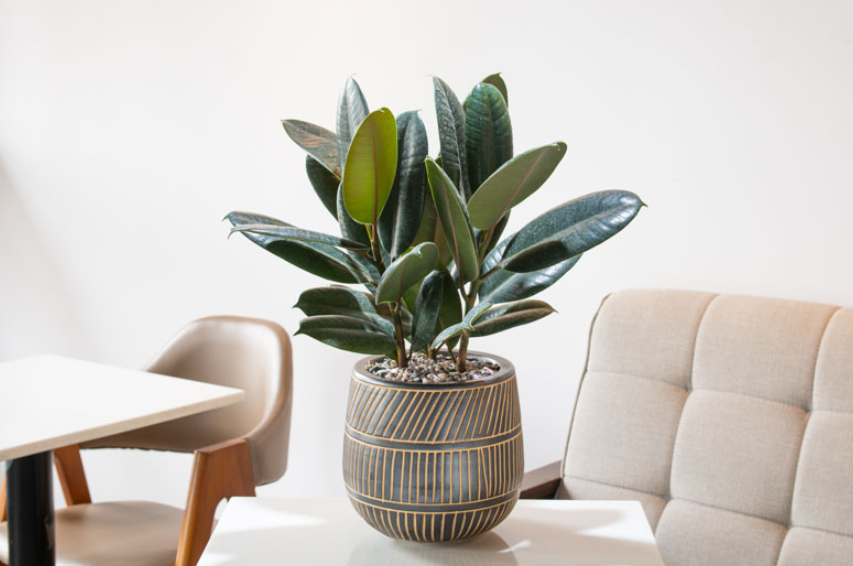
8. Pothos (Epipremnum aureum)
Pothos is a forgiving plant that survives in nearly any condition while helping to freshen the air. It is one of the easiest houseplants to care for, making it a great choice for beginning growers.
It is extremely low-maintenance and adds instant greenery to any room. Its trailing vines feature heart-shaped leaves streaked with gold or white, creating a simple but striking look.
This plant grows well even on gray winter days with limited sunlight. It is especially attractive in bedrooms, kitchens, or offices when placed on shelves or in hanging planters.
9. Bamboo Palm (Chamaedorea seifrizii)
The Bamboo Palm is one of the best indoor plants for air purification, known for its ability to freshen the air and add humidity during dry winter months. Its bamboo-like stalks and soft fronds bring a tropical feel indoors while helping Midwest homes stay more comfortable through heating season. Place it in a living room or bedroom with bright, indirect light, water regularly without over-soaking, and enjoy a plant that’s both attractive and practical.
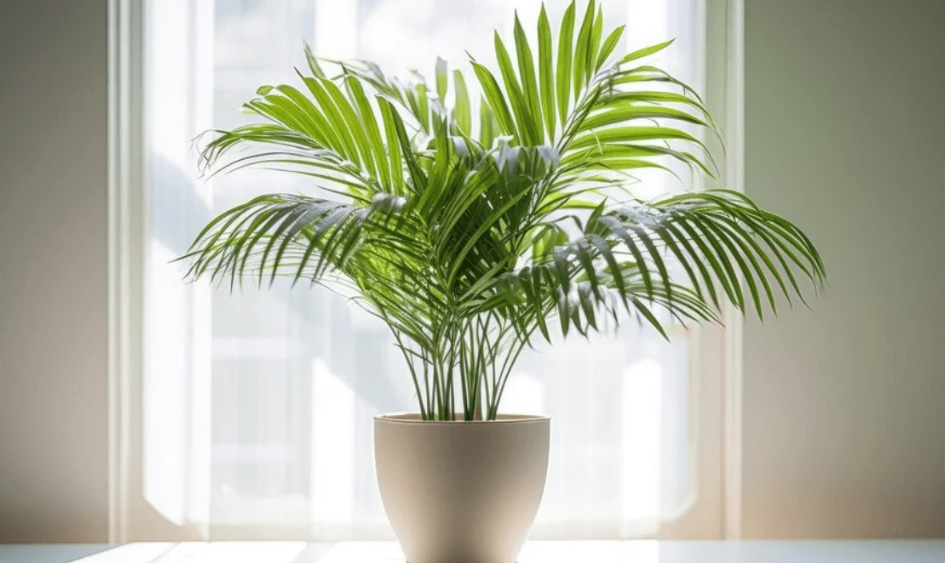
10. Dracaena (Dracaena spp.)
The Dracaena is a versatile houseplant with many popular varieties, including ‘Janet Craig’ and red-edged types, all valued for their ability to filter indoor air. Its long, strap-like leaves add striking texture and height to a room.
Dracaena tolerates dry indoor air better than many tropical plants. They thrive in medium light and do well in home offices, entryways, or living rooms. To care for this plant, simply allow the topsoil to dry before watering again, and enjoy a plant that is both stylish and low-maintenance.
11. Areca Palm (Dypsis lutescens)
The Areca Palm is one of the best plants for humidifying dry rooms, especially during Midwest winters. Its arching, feathery fronds bring brightness and movement to larger spaces while naturally helping balance dry, heated air.
Best placed in spacious living rooms, sunrooms, or foyers, this palm thrives in bright light and should be watered when the topsoil begins to dry. With minimal care, it grows into a striking, air-refreshing centerpiece.

12. Gerbera Daisy (Gerbera jamesonii)
The Gerbera Daisy brings a cheerful burst of color indoors with its bright pink, yellow, red, or orange blooms while also helping absorb certain indoor pollutants.
This plant grows best on sunny windowsills in bedrooms or kitchens where it can get plenty of light. Keep the soil evenly moist but not soggy, and enjoy a plant that combines beauty with function.
13. Philodendron (Philodendron spp.)
The Philodendron is a classic, nearly foolproof houseplant that’s loved for being easy to grow and hard to kill. Its large, heart-shaped leaves bring lush greenery indoors, with some species growing impressively large.
Philodendrons are a reliable choice as an indoor plant because they tolerate low light and dry winter air with ease. They do well in living rooms, offices, or on shelves, thriving in low to medium light. Care is simple: water when the soil is mostly dry, and enjoy a low-maintenance plant that adds lasting beauty to any room.
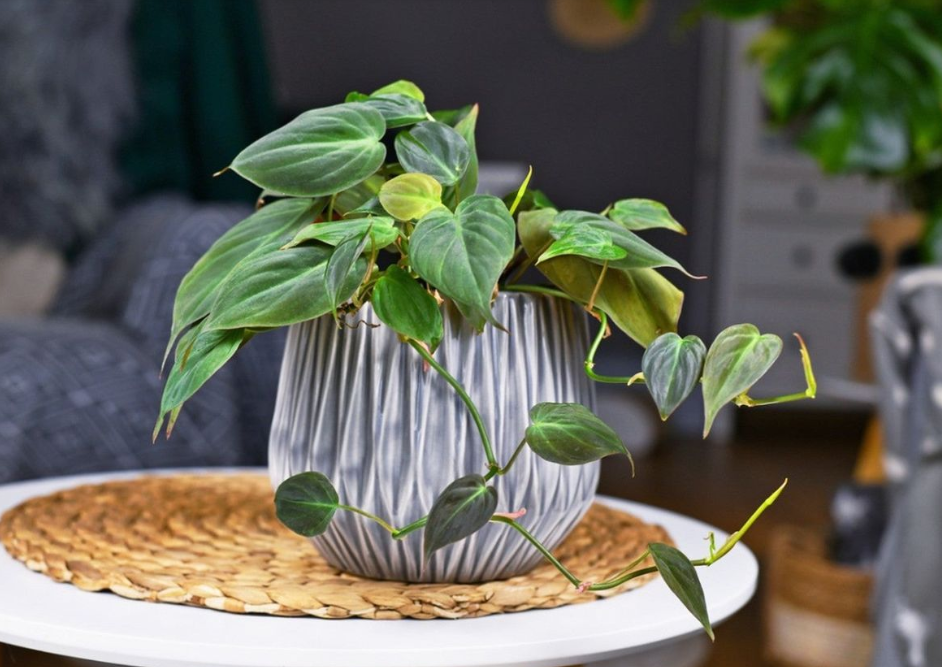
14. Weeping Fig (Ficus benjamina)
The Weeping Fig is admired for its tree-like form and ability to help refresh indoor air, making it a popular choice for larger rooms.
Its slender trunk supports dense, glossy leaves that create a full, elegant look indoors. In Midwest homes, it can serve as a “living tree” during long winters, bringing greenery inside when the outdoors feel bare.
Best placed in bright living rooms or foyers, the weeping fig thrives with consistent, bright light and moderate watering. Keep in mind it dislikes sudden changes in its environment, so try to avoid moving it around once it has settled.
15. Chinese Evergreen (Aglaonema)
The Chinese Evergreen is one of the most adaptable houseplants, thriving in low light and typical indoor conditions while also contributing to fresher air. Its striking variegated leaves, often patterned with silvery or red tones, add a decorative touch to any room.
It’s great for winter when natural light is limited and is also very low-maintenance. Ideal for bedrooms, hallways, or home offices, it grows best in low to medium light, with light watering as needed, making it a dependable choice for busy households.

16. ZZ Plant (Zamioculcas zamiifolia)
The ZZ Plant is an extremely hardy and resilient indoor plant, known for its ability to thrive even when neglected. Its upright, waxy, deep-green leaves create a polished, modern look while helping improve indoor air quality.
This plant tolerates low light and dry winter air with ease. ZZ plants do well in hallways, offices, or living rooms that don’t get much natural light. Care is simple: they grow in low to bright light conditions and only need watering every two to three weeks.
17. Lady Palm (Rhapis excelsa)
The Lady Palm is a classic indoor palm that helps improve air quality while adding a fresh, tropical feel to any room. Its elegant fan-shaped fronds and slow growth make it easy to manage, even in smaller indoor spaces.
This plant tolerates low light and indoor heating, making it especially useful during long winters when natural sunlight is limited. Lady palms look beautiful in entryways, living rooms, or corners near north- or east-facing windows. With simple care (watering when the top inch of soil is dry, avoiding cold drafts, and maintaining moderate humidity), this plant offers both style and resilience year-round.
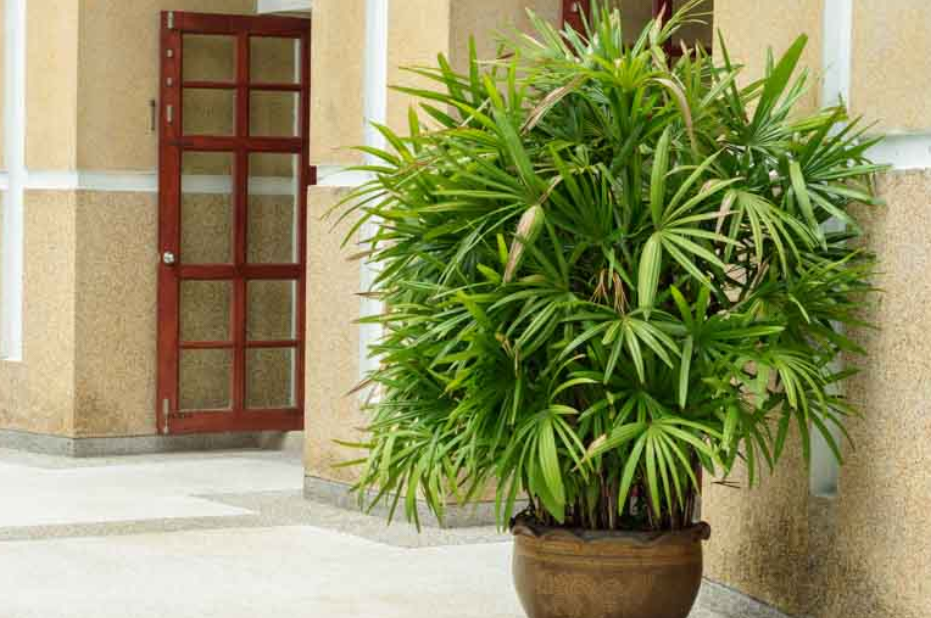
18. Pygmy Date Palm (Phoenix roebelenii)
The Pygmy Date Palm brings graceful greenery into the home while helping filter indoor air, offering a tropical look without overwhelming smaller spaces.
Unlike larger palm species, its compact size makes it perfect for Midwest households that want elegance in limited areas. It adjusts well to indoor conditions, tolerating the seasonal shift between dry winters and more humid summers. This palm thrives in living rooms or sunrooms when placed near an east- or west-facing window, where it can enjoy soft morning or afternoon sun.
For best results, use a well-draining potting mix, water when the soil is partly dry, and avoid harsh afternoon sunlight that can scorch its fronds.
19. Kimberly Queen Fern (Nephrolepis obliterata)
The Kimberly Queen fern is a lush, vibrant plant that helps remove indoor pollutants while adding greenery that instantly brightens a room. Unlike some ferns, its sturdy, upright fronds are less messy, making it easier to care for and maintain indoors.
This plant naturally increases humidity, which can help balance the dry air caused by winter heating. Kimberly Queen ferns thrive in bathrooms, kitchens, or laundry rooms where moisture levels are higher, or when placed near a bright window with indirect light. To keep them healthy, maintain consistently moist soil, provide gentle light, and trim away older fronds to encourage fresh new growth.

20. Ficus Alii (Ficus maclellandii)
The Ficus Alii is a stylish and practical indoor plant that helps filter the air while being less temperamental than other ficus varieties. Its long, narrow leaves create a sleek, modern look that complements a wide range of interior styles.
It thrives in bright living rooms or offices, especially near an east-facing window, and benefits from occasional rotation to ensure even growth. To keep it healthy, maintain evenly moist but not soggy soil, provide consistent bright light, and dust the leaves regularly to support proper photosynthesis.
21. Money Tree (Pachira aquatica)
The Money Tree is one of the best indoor plants for air purification, while also being a symbol of luck and positive energy in many homes. Its braided trunk and lush, vibrant leaves make it a striking statement piece that fits beautifully into modern living spaces.
For Midwest households, the money tree is a hardy, adaptable option that thrives indoors despite the drastic seasonal shifts between dry winters and humid summers.
It grows best in bright living or dining rooms with indirect sunlight, and many people place it in the “wealth corner” for good feng shui. To keep it healthy, water when the top inch of soil is dry, avoid overwatering during the winter, and use a peat-based potting mix for proper drainage.
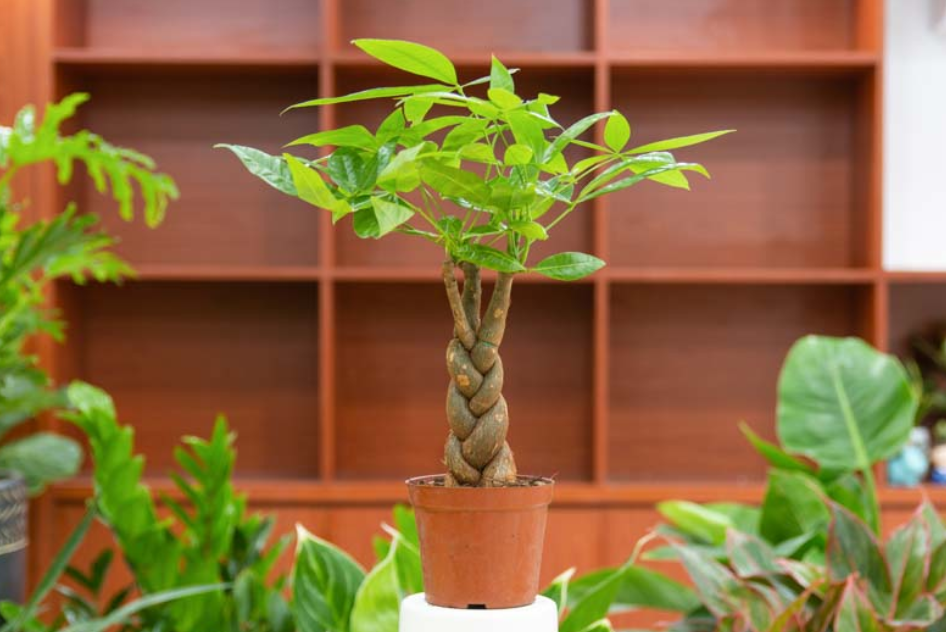
Best Plants for Indoors with Little Light
Not every home has big, sunny windows—and that’s where the best plants for indoors with little light truly shine. These options thrive in dim corners, hallways, or during the cloudy Midwest winters when natural light is scarce:
- Snake Plant (Sansevieria): This plant is nearly indestructible, thrives on neglect, and continues to clean the air even in low-light conditions.
- ZZ Plant (Zamioculcas zamiifolia): The ZZ plant handles very little light, requires minimal watering, and adds a modern look with its glossy green leaves.
- Peace Lily (Spathiphyllum): The peace lily grows well in shaded spaces and produces elegant white blooms that brighten darker rooms.
- Chinese Evergreen (Aglaonema): This plant stays lush and colorful even in low-light areas and is very easy for homeowners to maintain.
- Philodendron: A philodendron is a versatile plant that can trail or grow upright, thriving in shaded corners with minimal fuss.
- Lady Palm (Rhapis excelsa): The lady palm is a slow-growing plant that adds elegance to a space while tolerating indirect or low light.
These plants are perfect for Midwest homes where long winters and cloudy days limit sunlight, helping homeowners enjoy greenery and fresher air year-round, even in the coziest corners.
Which Plant Is Right for You?
Choosing the right indoor plant isn’t just about looks—it’s about finding the one that fits your home, lifestyle, and even personality. Here are a few ways to decide which plant is your perfect match:
For Low-Light Homes or Apartments
Go for plants like the Snake Plant or ZZ Plant. These are almost unkillable, thrive in darker corners, and are perfect if you don’t get much natural sunlight.
For Bright, Sunny Rooms
Try an Areca Palm or Money Tree. These plants love indirect sunlight and will reward you with fast, vibrant growth. Perfect for a living room or sunroom.
For Busy Homeowners (Low Maintenance)
The Peace Lily and Lady Palm are forgiving and need little fuss. They’re great if you travel often or forget to water sometimes.
For Allergy-Friendly Choices
Opt for plants like the Kimberly Queen Fern. This fern doesn’t shed as much as others, making it cleaner for sensitive households.
For Families and Pet Owners
Consider Areca Palm or Parlor Palm. They’re non-toxic to pets (unlike some other common houseplants) and safe if curious kids or pets get too close.
For Boosting Mood & Energy
A Money Tree isn’t just pretty—it’s tied to positive energy and prosperity in feng shui, making it a fun addition to a home office or entryway.
For Statement Décor
The Ficus Alii is tall and dramatic, perfect if you want a plant that doubles as a design feature in your home.
How to Choose the Best Indoor Plants for Your Midwest Home
Picking indoor plants isn’t just about looks; it’s about matching the right plant to your home’s environment so it can thrive. Midwest homes face unique challenges, from dry indoor air during long winters to humid summers and fluctuating light levels. Here’s what to consider when selecting indoor plants:
Light Availability
Light is the number one factor in plant success. Homes in the Midwest often have shorter, darker winter days, which can stress sun-loving plants. If your home has lots of bright windows, you can grow tropical varieties like palms and ficus. If not, stick with low-light champions like snake plants, pothos, or ZZ plants that can handle dim corners.
Humidity Levels
Heated homes in winter get very dry, which can cause leaf tips to brown. Ferns and peace lilies love humidity but may struggle unless you mist them or use a humidifier. On the other hand, plants like succulents and cacti naturally tolerate drier air and are lower-maintenance.
Temperature Stability
Most houseplants like steady conditions between 65–75°F. Keep them away from drafty windows, radiators, or heating vents, since sudden swings in temperature can shock them.
Space and Growth Habits
Consider how much room you have. A tall fiddle leaf fig or money tree makes a bold statement in a living room, while compact plants like pothos or ferns are better for shelves, desks, or smaller apartments.
Maintenance Level
Be honest about how much time you want to spend caring for plants. If you want a “set it and forget it” option, go for hardy varieties like snake plants or ZZ plants. If you enjoy tending to greenery, ferns or orchids can be rewarding, but they require more attention.
Air-Purifying Benefits
While no single plant can replace an air purifier, studies show that plants can help absorb small amounts of pollutants and boost oxygen levels. In the Midwest, where homes are often closed up for long winters, adding greenery can make your air feel fresher and your home more inviting.
How to Pair Plants with Other Air Quality Strategies
Indoor plants can make your home feel fresher, calmer, and even more inviting—but it’s important to know their limits. Here’s how to pair plants with other air quality strategies:
Use Proper Ventilation
One of the best ways to improve indoor air is to bring in fresh outdoor air when possible. Even cracking a window for 10–15 minutes a day can help dilute indoor pollutants.
Run Air Purifiers When Needed
A high-quality air purifier with a HEPA filter captures dust, pollen, and even smoke particles much more efficiently than plants. This is especially important if anyone in your home has allergies or asthma.
Control Humidity
Many Midwest homes get too dry in winter and too humid in summer. Keeping humidity between 30–50% helps prevent mold growth, keeps your lungs comfortable, and supports healthy plant growth, too.
Reduce Indoor Pollution at the Source
Everyday items like candles, cleaning products, paints, or even cooking can release pollutants. Switching to low-VOC paints, natural cleaners, and using a vented kitchen hood can make a big difference.
Think of plants as the “supporting cast” of your home’s air quality strategy. They make your space healthier and more pleasant, but the “main actors” are ventilation, air filtration, and good household habits. When you combine all these, you’ll have a home that not only looks good with greenery but also feels noticeably fresher and healthier to live in.
Best Potting Soil for Indoor Plants
Choosing the right potting soil is like giving your houseplants a healthy home. The soil mix you use affects how well your plants breathe, drink, and grow, especially in Midwest homes where winter heating dries the air and summer humidity can stress roots. Unlike outdoor garden soil, which is often too heavy and full of pests, high-quality indoor potting mixes are designed to keep your plants thriving in containers.
Here’s what makes the best potting soils for indoor plants—and why it matters for your home:
Light and Fluffy Structure
Roots need air as much as they need water, and the best potting soil provides a loose, well-aerated mix. This creates tiny air pockets that allow roots to breathe and spread out, while dense or compact soil can suffocate them and cause weak or stunted growth.
Good Moisture Retention
Your potting soil should include ingredients like peat moss or coconut coir that hold water just long enough for roots to drink without becoming soggy. This is especially important in heated homes, where plants can dry out more quickly.
Excellent Drainage
Healthy plants need protection from standing water, which causes root rot. Choose a potting soil that uses drainage boosters like perlite, sand, or vermiculite, allowing extra water to escape while still holding enough moisture for roots.
Sterile and Soilless Mix
Outdoor soil can bring pests, fungi, or weeds into your home. The best potting soil for indoor plants is sterile and soilless, meaning it is cleaner, lighter, and specially blended for container use, keeping both your plants and your home healthier.
Balanced Nutrients
Plants grown in containers rely heavily on the nutrients in their soil. The best potting soil will contain slow-release fertilizer or organic compost, giving your plants a steady food supply that supports strong growth and lush leaves.
Custom Blends for Plant Type
Not all houseplants need the same type of soil. Pick a potting soil tailored to your plant—succulents and cacti do best in sandy, fast-draining soil, while ferns and tropicals thrive in richer, moisture-retaining mixes. Using the right blend ensures each plant gets exactly what it needs to stay healthy.
Seasonal changes in the Midwest create unique challenges for indoor plants. Dry winter air and humid summers can stress roots, but the right potting mix helps balance these extremes. With the right soil foundation, your plants can stay greener, healthier, and more resilient all year round.
What To Do if Your Indoor Plants Show These Problems
Even the best houseplants can show signs of stress if their needs aren’t met. The good news is, most issues are easy to fix once you know what to look for. Here are some of the most common indoor plant problems and how to handle them:
Yellowing Leaves
Yellow leaves are usually a sign of overwatering, poor drainage, or lack of light. To fix this, let the soil dry out before watering again, make sure the pot has drainage holes, and move the plant to a brighter spot if needed.
Brown Tips or Edges
Brown tips often happen when the air is too dry or when salts from tap water and fertilizer build up in the soil. Mist the leaves occasionally, use a humidifier nearby, and flush the soil with water every few months to wash away excess minerals.
Drooping or Wilting
If your plant looks droopy, it could be from too little water, too much water, or sudden temperature changes. Check the soil—if it’s dry, give it a good soak; if it’s soggy, let it dry out before watering again. Also, keep plants away from cold drafts, heaters, or AC vents.
Slow or No Growth
When plants stop growing, it often means they’re not getting enough light or nutrients, or they’ve entered a natural dormant phase, especially in winter. Move the plant closer to a sunny window, rotate it regularly for even light, and feed it with a gentle houseplant fertilizer during spring and summer.
Leaf Drop
A sudden drop in leaves usually means the plant has experienced a big environmental change—such as being moved, changes in lighting, or temperature swings. The best fix is patience: keep conditions steady and avoid moving the plant around too often.
Pests (like tiny webs, sticky leaves, or little bugs)
Spider mites, aphids, or mealybugs sometimes show up on indoor plants. Wipe the leaves with a damp cloth, spray with soapy water or neem oil, and keep the plant isolated until the pests are gone.
FAQs
Do air-purifying plants get rid of smells?
While plants can absorb certain airborne compounds and help make indoor air feel fresher, they are not powerful odor eliminators. For lingering odors such as cooking smells or pet odors, mechanical ventilation or air purifiers with activated carbon filters are much more effective.
How many plants do you need to purify the air in your home?
Research shows that while plants do help clean the air, you’d actually need a huge number of them, anywhere from 10 to 1,000 plants per square meter, to make a big difference. In most homes and offices, the building’s natural airflow and ventilation already do most of the work of removing indoor pollutants. To put it in perspective, you’d need around 680 plants to see real results in a typical 1,500-square-foot house—basically turning your living room into a greenhouse.
Which air-purifying plants are safe for kids and pets?
Some popular low-toxicity options include Spider Plant, Areca Palm, and Boston Fern. However, be aware that many classic air-purifying plants like Snake Plant, Rubber Plant, Pothos, Philodendron, English Ivy, Aloe Vera, Peace Lily, and Weeping Fig are toxic to pets and/or children and should be placed out of reach.
Which indoor plants trigger allergies?
If you or a family member suffers from allergies, consider avoiding these plants:
- Ferns: These plants release spores into the air, which can sometimes trigger respiratory irritation.
- Weeping Fig (Ficus benjamina): This plant is known to aggravate allergic rhinitis and asthma.
- Peace Lily: While it offers air-purifying benefits, the peace lily has been linked to contact dermatitis in people with sensitive skin.
- English Ivy: This common houseplant contains compounds that may trigger skin irritation or allergic reactions in some individuals.
Indoor plants may not replace an air purifier, but they can still make your home feel fresher, reduce stress, and bring life to every room. The key is choosing plants that fit your lifestyle and light levels, then pairing them with good airflow and healthy habits.
To take that freshness a step further, consider enrolling in an Earth-Friendly Electricity Plans that supports the growth of renewable energy. Just like your plants, it’s a simple way to keep your home earth-friendly inside and out.
Jenna Mendez is a Midwest native with lifelong roots in Illinois and time spent in Ohio during college, giving her a deep understanding of the Midwest region’s people, climate, and energy needs. She brings firsthand experience and local insight to topics that matter to Midwest homeowners, especially energy efficiency, sustainability, and home living. Jenna specializes in writing about eco-friendly living, all things Midwest, renewable energy, and practical ways to reduce energy costs. Jenna brings a trusted, and local hometown voice to every article she writes, helping readers live well, and sustainably, right where they are.




